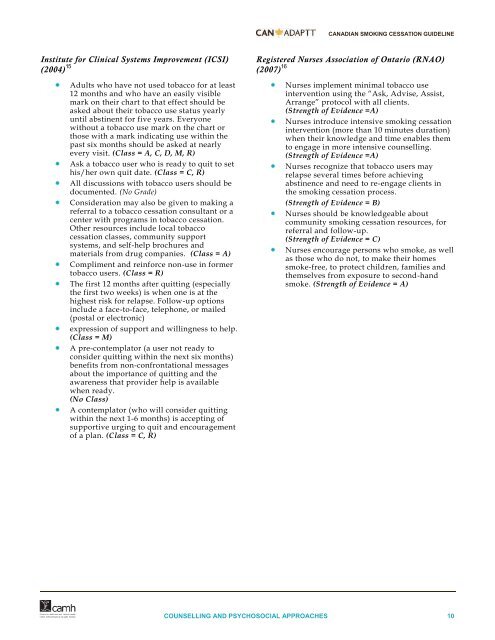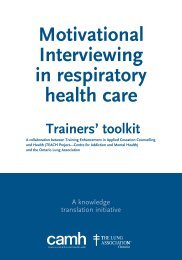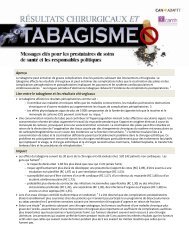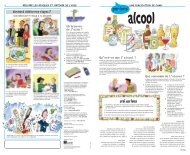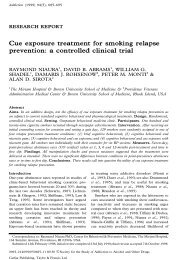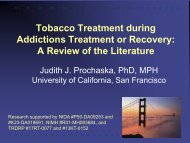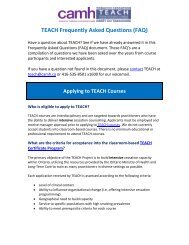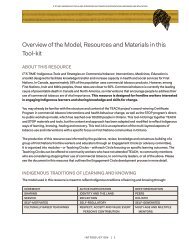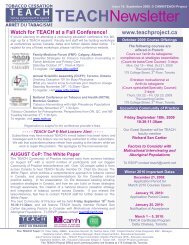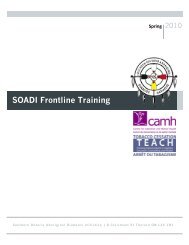CANADIAN SMOKING CESSATION GUIDELINEeffective than less intensive interventions andshould be used whenever possible. (Strengthof Evidence = A) Person-to-person treatmentdelivered for four or more sessions appearsespecially effective in increasing abstinencerates. Therefore, if feasible, clinicians shouldstrive to meet four or more times withindividuals quitting tobacco use. (Strength ofEvidence = A)Treatment delivered by a variety of cliniciantypes increases abstinence rates. Therefore,all clinicians should provide smokingcessation interventions. (Strength of Evidence= A) Treatments delivered by multiple typesof clinicians are more effective thaninterventions delivered by a single type ofclinician. Therefore, the delivery ofinterventions by more than one type ofclinician is encouraged.(Strength of Evidence = C)Proactive telephone counselling, groupcounselling, and individual counsellingformats are effective and should be used insmoking cessation interventions. (Strength ofEvidence = A) <strong>Smoking</strong> cessationinterventions that are delivered in multipleformats increase abstinence rates and shouldbe encouraged. (Strength of Evidence = A)Tailored materials, both print and Web-based,appear to be effective in helping people quit.Therefore, clinicians may choose to providetailored self-help materials to their patientswho want to quit.(Strength of Evidence = B)All patients who receive a tobaccodependence intervention should be assessedfor abstinence at the completion of treatmentand during subsequent contacts. (1)Abstinent patients should have their quittingsuccess acknowledged, and the clinicianshould offer to assist the patient withproblems associated with quitting. (2)Patients who have relapsed should beassessed to determine whether they arewilling to make another quit attempt.(Strength of Evidence = C)Two types of counselling and behaviouraltherapies result in higher abstinence rates: (1)providing smokers with practical counselling(problem-solving skills/skills training), and(2) providing support and encouragement aspart of treatment. These types of counsellingelements should be included in smokingcessation interventions. (Strength of Evidence= B)The combination of counselling andmedication is more effective for smokingcessation than either medication orcounselling alone. Therefore, wheneverfeasible and appropriate, both counsellingand medication should be provided topatients trying to quit smoking. (Strength ofEvidence = A) There is a strong relationbetween the number of sessions ofcounselling, when it is combined withmedication, and the likelihood of successfulsmoking cessation. Therefore, to the extentpossible, clinicians should provide multiplecounselling sessions, in addition tomedication, to their patients who are trying toquit smoking. (Strength of Evidence = A)Motivational intervention techniques appearto be effective in increasing a patient’slikelihood of making a future quit attempt.Therefore, clinicians should use motivationaltechniques to encourage smokers who are notcurrently willing to quit to consider making aquit attempt in the future. (Strength ofEvidence = B)New Zealand Ministry of Health (2007) 14Ask about and document smoking status forall patients. For people who smoke or haverecently stopped smoking, the smoking statusshould be checked and updated on a regularbasis. Systems should be in place in all healthcare settings (medical centres, clinics,hospitals, etc.) to ensure that smoking statusis accurately documented on a regular basis.(Grade = A)All doctors should provide brief advice toquit smoking at least once a year to allpatients who smoke. (Grade = A) All otherhealth care workers should also provide briefadvice to quit smoking at least once a year toall patients who smoke. (Grade = B) Recordthe provision of brief advice in patientrecords. (Grade = C) Aim to see people for atleast four cessation support sessions. (Grade =A)Health care workers providing evidencebasedcessation support (that is, more thanjust brief advice) should seek appropriatetraining. (Grade = C) Health care workerstrained as smoking cessation providersrequire dedicated time to provide cessationsupport. (Grade = C)Offer telephone counselling as an effectivemethod of stopping smoking. People whosmoke can be directed to Quitline (toll-free:0800 778 778). (Grade = A) Providing face-tofacesmoking cessation support either toindividual patients or to groups of smokers isan effective method of stopping smoking.(Grade = A) Make self-help materialsavailable, particularly those that are tailoredto individuals, but such materials should notbe the main focus of efforts to help peoplestop smoking. (Grade = √)COUNSELLING AND PSYCHOSOCIAL APPROACHES 9
CANADIAN SMOKING CESSATION GUIDELINEInstitute for <strong>Clinical</strong> Systems Improvement (ICSI)(2004) 15 Adults who have not used tobacco for at least12 months and who have an easily visiblemark on their chart to that effect should beasked about their tobacco use status yearlyuntil abstinent for five years. Everyonewithout a tobacco use mark on the chart orthose with a mark indicating use within thepast six months should be asked at nearlyevery visit. (Class = A, C, D, M, R)Ask a tobacco user who is ready to quit to sethis/her own quit date. (Class = C, R)All discussions with tobacco users should bedocumented. (No Grade)Consideration may also be given to making areferral to a tobacco cessation consultant or acenter with programs in tobacco cessation.Other resources include local tobaccocessation classes, community supportsystems, and self-help brochures andmaterials from drug companies. (Class = A)Compliment and reinforce non-use in formertobacco users. (Class = R)The first 12 months after quitting (especiallythe first two weeks) is when one is at thehighest risk for relapse. Follow-up optionsinclude a face-to-face, telephone, or mailed(postal or electronic)expression of support and willingness to help.(Class = M)A pre-contemplator (a user not ready toconsider quitting within the next six months)benefits from non-confrontational messagesabout the importance of quitting and theawareness that provider help is availablewhen ready.(No Class)A contemplator (who will consider quittingwithin the next 1-6 months) is accepting ofsupportive urging to quit and encouragementof a plan. (Class = C, R)Registered Nurses Association of Ontario (RNAO)(2007) 16 Nurses implement minimal tobacco useintervention using the “Ask, Advise, Assist,Arrange” protocol with all clients.(Strength of Evidence =A)Nurses introduce intensive smoking cessationintervention (more than 10 minutes duration)when their knowledge and time enables themto engage in more intensive counselling.(Strength of Evidence =A)Nurses recognize that tobacco users mayrelapse several times before achievingabstinence and need to re-engage clients inthe smoking cessation process.(Strength of Evidence = B)Nurses should be knowledgeable aboutcommunity smoking cessation resources, forreferral and follow-up.(Strength of Evidence = C)Nurses encourage persons who smoke, as wellas those who do not, to make their homessmoke-free, to protect children, families andthemselves from exposure to second-handsmoke. (Strength of Evidence = A)COUNSELLING AND PSYCHOSOCIAL APPROACHES 10


